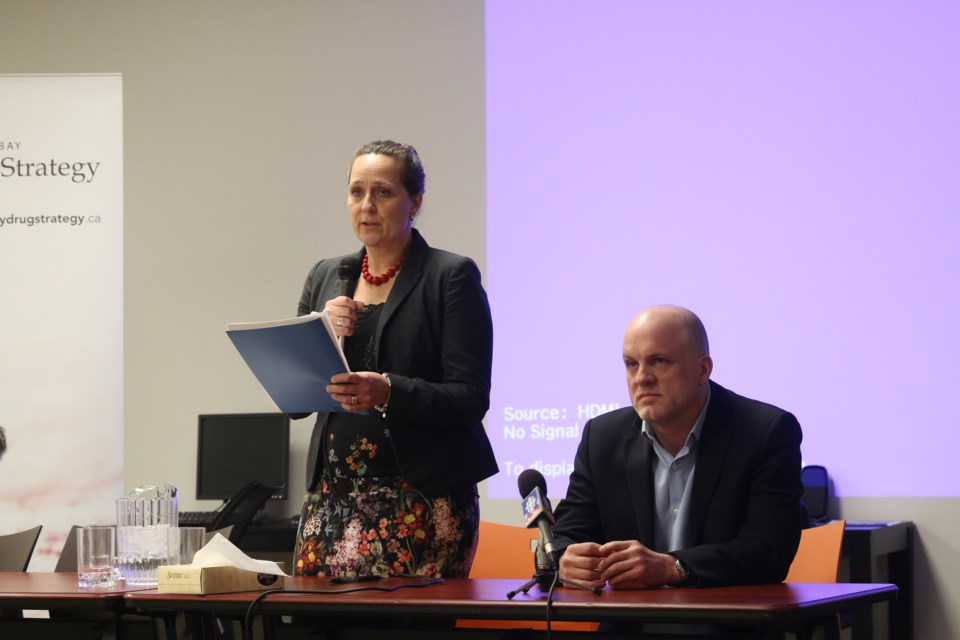THUNDER BAY - With high rates of injection drug use on city streets, a new study shows supervised injection sites are needed in both downtown cores.
Results of a feasibility study released Tuesday found supervised injection sites (SIS) in Thunder Bay will greatly benefit the community by reducing the transmission of infectious diseases, overdoses, and promote access to addiction treatment.
“I think these facilities constitute a win-win solution,” said Thomas Kerr, professor in faculty of medicine at University of British Columbia and research scientist at the B.C. Centre for excellence in HIV and Aids.
“Communities are safer as a result of these facilities, deal with less public disorder related to injecting and people who use drugs get the health care they need. If you are someone who is angry about discarded syringes in their neighbourhood, are tired of seeing people injecting, then you are in favour of safe infection sites.”
Kerr lead the Ontario Integrated Supervised Injection Services Feasibility Study for Thunder Bay. The study began in March, 2016 with the Ontario HIV Treatment Network and the Thunder Bay Drug Strategy.
The study surveyed 200 people in Thunder Bay who use injection drugs and found that the majority of them support supervised injection sites.
“We found that around 69 per cent said they would be willing to use safe injection sites if one was available,” Kerr said. “Those who said yes, had many risks for drug related harm, high intensity injectors, or inject in public places.”
Of those surveyed, 31 per cent admitted to daily drug use, with 27 per cent used drugs more than once a week.
The survey also found 88 per cent injected cocaine, with morphine and hydromorphone at 65 per cent and 50 per cent respectively. Respondents also indicated that injecting at their own place was most common, with 68 per cent, while 46 per cent admitted to injecting in a public washroom and 34 per cent in an alley or laneway.
“We had the opportunity in Vancouver to look at whether people who say they will use an injection site actually use one once it’s open, and we found that they do,” Kerr said. “It lends some credibility to this type of work, which is really meant to help municipalities plan.”
The study also found that 74 per cent of those surveyed used injected drugs in the Thunder Bay south core, with the remaining 17 per cent in the north core.
According to Kerr, the city would benefit from two separate supervised injection sites in each down town core because of the geographic makeup of the city and the habits of injection drug users.
“The truth is, people will not walk miles and miles to use these facilities,” Kerr said. “They need to be close and accessible to where people live and where they buy and consume drugs. It really depends on how the population is spread out.”
Thunder Bay Drug Strategy chair, Rebecca Johnson, agrees that two facilities are needed in the city of Thunder Bay, and that is how the plan will be brought to the community when seeking input.
“We need to look at a north and a south core location,” she said. “It would be easier to get to two sites than just one. And if you had just one, then where would you place it? The recommendation was for two sites, so that is what we would be looking at.”
There were 17 major stakeholders including police, healthcare, social services, government, and business sectors in the city consulted in the study. The majority agree that two supervised injection sites are needed in the city.
“The [stakeholders] wanted it to be an integrated hub where people can do more than inject drugs under supervision, they want to see them have access to a whole variety of services including things like addiction treatment, counselling, mental health support, and the like,” Kerr said.
“These facilities are very unique, because by accommodating the cycle of active drug use in a health care facility, it affords the opportunity for health care professionals to connect with the population and refer them to those services,” he added.
The next step following the release of the study will be taking the information to the public to get feedback from the community. Johnson said supervised injection sites are not something any city wants to see, but the study identifies that it is something Thunder Bay needs.
“Is it going to be a hurdle? Everything is a hurdle,” she said. “But I don’t think that is something that should deter us from what we want to move forward. I think now we have to look at going to the community and talking to them.”
Johnson hopes to move the process forward within a year. When it comes to paying for possible injection sites, Johnson said the province of Ontario has expressed support for moving in the same direction and she hopes financial support will be made available as well.
For Kerr, there is no escaping that drug use is happening in the city of Thunder Bay, so it is up to the people of the city to decide how that drug use takes place.
“The question becomes where would you prefer it happening, in playgrounds and alleyways, or would you rather have it in a health care facility where people are safe, where the risk of disease transmission is reduced, where they can get access to other health care resources,” Kerr said.
The full study is available at the Ontario HIV Treatment Network website.
